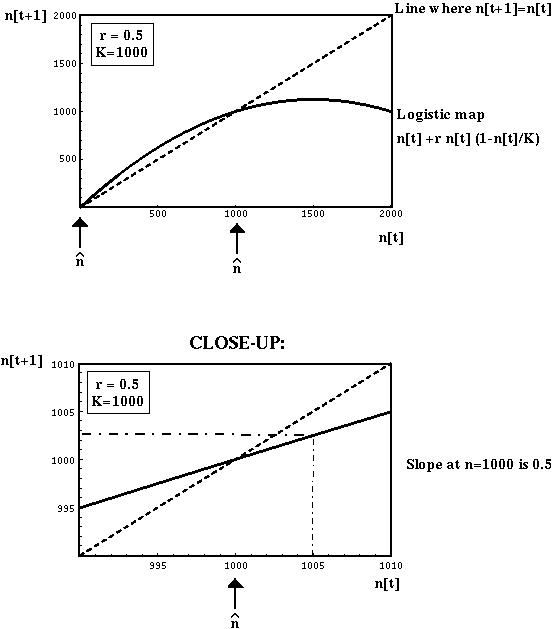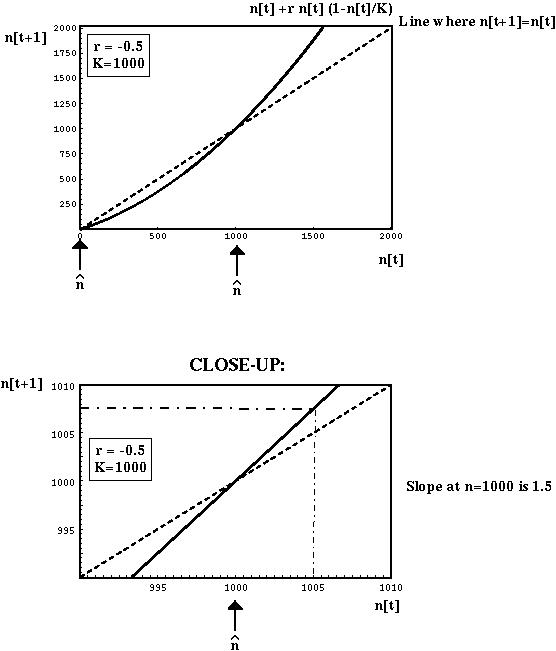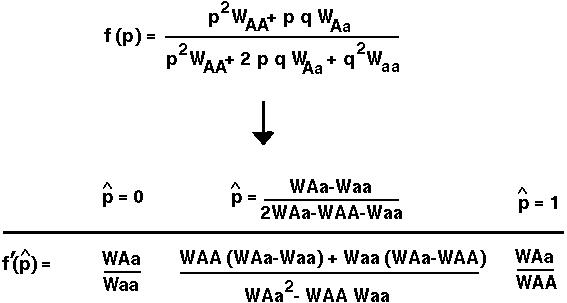
Methods of Analysis. III. Stability



What happens to a point very near an equilibrium?
If points near an equilibrium tend to move towards the equilibrium over time, the equilibrium is said to be locally stable.
If points near an equilibrium tend to move away from the equilibrium over time, the equilibrium is said to be locally unstable.
By definition, when we say that an equilibrium pointis locally stable, we mean that all solutions which begin from an initial condition close to
converge to
as time goes to infinity.
-- Roughgarden p.557
An equilibrium point is said to be globally stable if all initial starting conditions lead to it.
Goal: To determine whether a small perturbation away from an equilibrium point will grow or shrink in magnitude over time.


Mathematical Aside: Taylor Series
Most nicely behaved functions, f(x), can be rewritten as:

where  is the kth derivative of the function with respect to x evaluated at the point a. (This is proven in many calculus books.)
is the kth derivative of the function with respect to x evaluated at the point a. (This is proven in many calculus books.)
How does this help?
If we have an equilibrium point, call it a, and we have a starting condition x which is near a, then we can use the Taylor Series to rewrite the equations that describe how the system changes over time.
If we start near enough to the equilibrium, (x-a)k will be tiny for k greater than one and the function will be dominated by the first two terms in the sum with k=0 and k=1:

This is great! No matter how complicated and non-linear an equation we have, we can get an approximate equation that describes the dynamics near an equilibrium point. This approximate equation is linear in x and can be easily analysed.


Given a recursion equation in one variable (x[t+1] = f(x)) with an equilibrium  , when will a small perturbation (
, when will a small perturbation ( ) away from the equilibrium grow in magnitude over time?
) away from the equilibrium grow in magnitude over time?
At time t, say that the population is a small distance from the equilibrium:  +
+  [t]. (Note that
[t]. (Note that  [t] might be negative.)
[t] might be negative.)
At time t+1, the population will be at  +
+  [t+1], which equals f(
[t+1], which equals f( +
+  [t]).
[t]).
Using the Taylor Series of this function:

But we know that f( ) =
) =  , since at equilibrium the system does not change over time.
, since at equilibrium the system does not change over time.
Therefore

The perturbation will
 ) is positive
) is positive
 ) is greater than one (
) is greater than one ( locally unstable)
locally unstable)
 ) is between zero and one (
) is between zero and one ( locally stable)
locally stable)
 ) is negative
) is negative
 ) is below negative one (
) is below negative one ( locally unstable)
locally unstable)
 ) is between negative one and zero (
) is between negative one and zero ( locally stable)
locally stable)
These conditions have a fairly simple graphical interpretation.
As an example, we'll consider the logistic equation in discrete time, with K=1000 and r=+/-0.5.
For populations started near carrying capacity (e.g. n[t]=1005), the slope of the recursion equation predicts whether the system will move closer to or further away from the equilibrium.




Again we focus on a small perturbation ( ) away from an equilibrium (
) away from an equilibrium ( ) and determine whether this perturbation will grow or shrink.
) and determine whether this perturbation will grow or shrink.
If at time t the population is a small distance from equilibrium:  +
+  [t], the rate of change in x will be dx/dt = d(
[t], the rate of change in x will be dx/dt = d( +
+  [t])/dt.
[t])/dt.
In this case, dx/dt is the function that we wish to approximate using the Taylor Series:

Now, f( ) equals zero, since dx/dt = 0 at equilibrium.
) equals zero, since dx/dt = 0 at equilibrium.
Furthermore, by the linearity property of derivatives:

Therefore, the perturbation will change over time at a rate

The perturbation will
 ) is positive (
) is positive ( locally unstable),
locally unstable),
 ) is negative (
) is negative ( locally stable).
locally stable).


Let f(n) = n[t+1] = R n[t] and note that the only equilibrium is  = 0.
= 0.
For the stability analysis in discrete time we must find
f'( ).
).
f'( ) therefore equals
R.
) therefore equals
R.
 will shrink (
will shrink ( =0 is locally stable).
=0 is locally stable).
 will grow (
will grow ( =0 is locally unstable).
=0 is locally unstable).
Now let f(n) = dn/dt = r n. Again the only equilibrium is  = 0.
= 0.
For the stability analysis in continuouus time we must find
f'( ).
).
f'( ) therefore equals
r.
) therefore equals
r.
 will shrink (
will shrink ( =0 is locally stable).
=0 is locally stable).
 will grow (
will grow ( =0 is locally unstable).
=0 is locally unstable).


For the one-locus selection model, the recursion function is:

To perform a Taylor Series analysis, we first must find the derivative of f with respect to p:

The first equilibrium of the haploid model is  =0. At this equilibrium,
=0. At this equilibrium,

Therefore, if we start at some point near 0, say  [t], then in the next generation the allele frequency will be approximately
[t], then in the next generation the allele frequency will be approximately  [t] WA/Wa.
[t] WA/Wa.
The allele frequency will move towards zero if WA < Wa ( =0 is locally stable).
=0 is locally stable).
The allele frequency will move away from zero if WA > Wa ( =0 is locally unstable).
=0 is locally unstable).


The other equilibrium in the haploid model is  =1. The derivative of the recursion function at this equilibrium is:
=1. The derivative of the recursion function at this equilibrium is:

Therefore, if we start at some point near 1, say 1- [t], then in the next generation the allele frequency will be approximately 1-
[t], then in the next generation the allele frequency will be approximately 1- [t] Wa/WA.
[t] Wa/WA.
The allele frequency will move towards one if WA > Wa ( =1 is locally stable).
=1 is locally stable).
The allele frequency will move away from one if WA < Wa ( =1 is locally unstable).
=1 is locally unstable).


A similar analysis can be performed using the continuous model. Now our function is dp/dt:

What will f'(p) equal?
There are two equilibria in this model,  =0 and
=0 and  =1.
=1.
What will f'(0) equal?
When will  =0 be stable?
=0 be stable?
When will  =0 be unstable?
=0 be unstable?
What will f'(1) equal?
When will  =1 be stable?
=1 be stable?
When will  =1 be unstable?
=1 be unstable?
When A is favored, the population moves toward fixation on A and away from fixation on a (and vice versa).


We have to evaluate f'( ) for each of the three equilibria of the diploid model, using the function, f(p), given by the recursion equation for the diploid selection model:
) for each of the three equilibria of the diploid model, using the function, f(p), given by the recursion equation for the diploid selection model:

Results:
 =0 grow if WAa > Waa but shrink if WAa < Waa.
=0 grow if WAa > Waa but shrink if WAa < Waa.
 =1 grow if WAa > WAA but shrink if WAa < WAA.
=1 grow if WAa > WAA but shrink if WAa < WAA.





We can rewrite f'( ) as
) as

We need only look at the cases where the polymorphic equilibrium is valid (lies between 0 and 1):
 will shrink (the internal polymorphic state is locally stable).
will shrink (the internal polymorphic state is locally stable).
 will grow (the internal polymorphic state is locally unstable).
will grow (the internal polymorphic state is locally unstable).